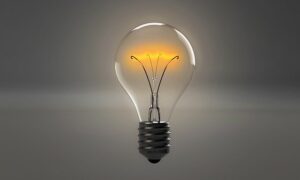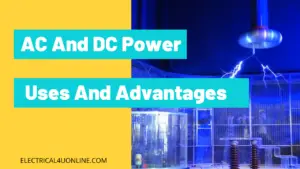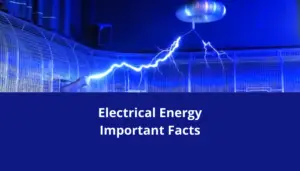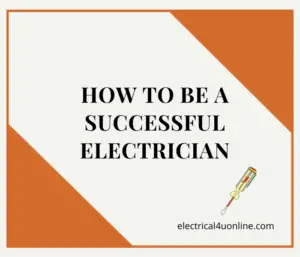Table of Contents
what is electrical energy?
Electrical energy refers to the energy that is carried by moving electrons in an electric conductor.
This form of energy is widely used for powering various devices and systems, ranging from household appliances to industrial machinery. It is a type of kinetic energy that is associated with the flow of electric charge.
Electrical energy is generated in power plants using various methods, such as burning fossil fuels, harnessing renewable energy sources like wind, water, or sunlight, or through nuclear reactions.
The unit of electrical energy is the kilowatt-hour (kWh), which is a measure of the amount of energy used over time. One kilowatt-hour is equivalent to using one kilowatt of power for one hour. This unit is commonly used for billing purposes by utility companies to measure electricity consumption.
Electrical energy is crucial for the functioning of modern society, as it powers most of the technology and infrastructure that we rely on daily.
It is a versatile and convenient form of energy, and advancements in electrical engineering continue to drive innovation and improve the efficiency of electrical energy generation, transmission, and utilization.
For more information about AC Generator, Read my detailed article here.
Applications Of Electrical Energy
Electrical energy has a wide range of applications across various sectors, contributing significantly to the functioning of modern society. Some of the key applications of electrical energy include:
- Residential and Commercial Use: Electrical energy is primarily used in homes and commercial establishments to power lighting, heating, air conditioning, refrigeration, and various household appliances such as televisions, computers, washing machines, and kitchen appliances.
- Industrial Sector: Electrical energy is a vital power source in the industrial sector, used for operating machinery, manufacturing equipment, and various industrial processes. It powers motors, pumps, compressors, and other heavy-duty machinery essential for production in industries such as manufacturing, mining, and construction.
- Transportation: Electric energy is increasingly being used to power various modes of transportation, including electric cars, buses, and trains. With the advancement of electric vehicle technology, electrical energy has become a sustainable alternative to traditional fossil fuel-powered vehicles, reducing greenhouse gas emissions and promoting environmental sustainability.
- Information Technology: Data centers, telecommunication networks, and the entire information technology infrastructure rely heavily on electrical energy to run servers, network equipment, and data storage systems. It is crucial for maintaining the functionality of the digital economy and global communication networks.
- Healthcare Sector: Electrical energy is essential for running medical equipment, such as X-ray machines, MRI scanners, CT scanners, and various life support systems in hospitals and healthcare facilities. It is also crucial for powering medical research equipment and laboratory instruments.
- Renewable Energy: Electrical energy is harnessed from renewable energy sources like solar, wind, hydro, and geothermal power to generate clean electricity. These sources are crucial for sustainable energy production, reducing the dependence on non-renewable fossil fuels and mitigating the environmental impact of energy generation.
- Agriculture: Electrical energy is used in various agricultural applications such as irrigation systems, crop processing equipment, and climate control systems in greenhouses and livestock facilities. It also powers machinery used for planting, harvesting, and processing agricultural products.
The applications of electrical energy continue to expand with advancements in technology, leading to increased efficiency, sustainability, and the development of new industries and services. For more about electrical energy uses, read my other article here.

Can Electrical Energy Be Converted To Chemical Energy?
In spite of the fact that there is no direct way to convert electrical energy into chemical energy, it is nevertheless possible to do so by way of a number of other processes in between.
In the process known as the electrochemical reaction, electrical energy is converted into chemical energy when electricity is utilized as a catalyst in a chemical reaction because electricity is a good conductor of energy.
In the electrolytic cell, chemical energy is produced by transforming electrical energy into chemical energy through the electrolysis of an electrolyte.
Electrolysis is a typical example of how they could interact with one another out of the numerous possible ways in which they could do so.
This process takes place in the electrolytic cell. Electrolysis, on the other hand, can be utilized in conjunction with a catalyst to break down chemical bonds that are present in a solution.
It is possible for energy to be transferred from its electrical form to its chemical form. Electrolysis is one of the most common and significant ways in which they interact with one another.
How Is Electrical Energy Converted Into Mechanical?
The vast majority of devices that are capable of transforming electrical energy into mechanical energy have an electric motor built into them.
These electric motors get their power from the interaction of the magnetic field of the motor with an electric current.
This reaction creates a torque, which in turn causes the shaft to rotate, which results in the release of mechanical energy.
An electric motor is a part of many machines and gadgets that help convert electrical energy into mechanical energy.
In the Case Of Ac Motor
An electromagnetic induction phenomenon is used by AC motors to transform alternating current into mechanical power. An AC motor’s basic operation is based on the magnetism principle.
The coil of wire transforms into an electromagnet when an alternating current (AC) charge is applied to it. A magnetic field is created by this electromagnet.
A solid metal axle, a wire loop, a coil, a metal-bar squirrel cage, and other freely revolving electrically conducting metal components are all found inside the stator. The stator outside coils get electricity when an AC motor is running.
A magnetic field that revolves around the outside of the motor is created by the coils being energized in pairs and sequentially.
In the Case Of DC Motor
DC motor is made up of the following components: the stator (magnet), the rotor (an axle with a coil attached to it that spins rapidly and functions as an electromagnet), the commutator or key, the power supply (DC), and brushes.
A magnetic field is produced whenever electric current passes through the coil (on the rotor), as we are all aware that magnetic fields are produced by current-carrying electric fields.
As a result of this generated magnetic field’s interactions with the stator’s magnetic field, torque is produced. The rotor spins as a result of the torque, producing mechanical energy.
What Shapes Of Energy Can Be Converted To Electrical Energy?
Electrical energy can be generated from various forms of energy through the process of energy conversion. Some of the common forms of energy that can be converted into electrical energy include:
- Mechanical Energy: Mechanical energy can be converted into electrical energy through the use of generators. This process involves the rotation of a turbine, which, when coupled with a conductor within a magnetic field, induces the flow of electrons, generating electrical energy. This method is widely used in hydroelectric, wind, and steam turbines.
- Light Energy: Light energy can be converted into electrical energy through photovoltaic cells or solar panels. These devices utilize the photovoltaic effect to convert sunlight directly into electricity. Solar energy is a renewable and sustainable source of electrical energy, commonly used in residential, commercial, and industrial applications.
- Chemical Energy: Chemical energy can be converted into electrical energy through electrochemical cells, such as batteries and fuel cells. Batteries use chemical reactions to produce a flow of electrons, thus generating electricity. Fuel cells, on the other hand, convert the chemical energy of a fuel directly into electrical energy and are used in various applications, including transportation and stationary power generation.
- Thermal Energy: Thermal energy can be converted into electrical energy through the use of thermoelectric generators. These devices utilize the Seebeck effect, which converts a temperature difference between two different materials into an electric voltage. Thermal energy is also used in steam turbines and geothermal power plants to generate electricity.
- Nuclear Energy: Nuclear energy can be converted into electrical energy through nuclear power plants. These plants use nuclear fission to generate heat, which is then used to produce steam and drive turbines, ultimately generating electrical energy. Nuclear power is a significant source of electricity in many countries.
- Electromagnetic Energy: Electromagnetic energy can be converted into electrical energy through electromagnetic induction. This principle is used in devices such as transformers, which can convert high-voltage and low-current electricity into low-voltage and high-current electricity or vice versa, facilitating the transmission and distribution of electrical energy in power grids.
These various forms of energy can be harnessed and converted into electrical energy, providing a diverse and sustainable range of sources for power generation and distribution.
Is there heat loss when electric energy is transferred to another shape?
Yes, there is typically heat loss when electrical energy is converted into other forms of energy. This loss can occur due to several factors such as resistance in conductors, friction, inefficiencies in the conversion process, and other forms of energy dissipation.
In electrical systems, resistance in wires and components leads to the generation of heat, which can result in energy loss. This phenomenon is described by Joule’s first law, which states that the power lost as heat in a conductor is directly proportional to the square of the current passing through it and the resistance of the conductor.
Furthermore, during the conversion of electrical energy to other forms such as mechanical, light, or thermal energy, not all the electrical energy is efficiently transformed. Some energy is lost in the form of heat due to the inefficiencies of the conversion process. For example, in electric motors, some energy is lost due to friction in moving parts and other mechanical inefficiencies.
Similarly, in light bulbs or any other light-emitting devices, some electrical energy is converted into light energy, but a portion of the energy is also lost as heat. This is why incandescent bulbs, which produce light through the heating of a filament, are not as energy-efficient as other types of lighting.
Therefore, it’s important to consider the efficiency of the conversion process when evaluating the overall energy loss during the transfer of electrical energy into other forms. Efforts are continually made to improve the efficiency of energy conversion processes in order to minimize energy losses and improve overall energy utilization.
Why Electrical Energy Is Transmitted At High Voltage?
Electrical energy is transmitted at high voltages primarily to reduce energy losses and increase the efficiency of power transmission over long distances. Several key reasons support the use of high voltage in the transmission of electrical energy:
- Reduced Energy Losses: According to Joule’s law, the power lost as heat in a conductor is directly proportional to the square of the current passing through it. By transmitting electricity at high voltages, the current can be reduced for a given amount of power, thus minimizing the energy losses that occur due to resistance in the transmission lines. Lower current means lower resistive losses, which significantly increases the overall efficiency of the transmission system.
- Increased Transmission Efficiency: High-voltage transmission enables the efficient transport of electricity over long distances. With reduced losses, more power can be transmitted from the power plant to the end-users, even over vast geographical areas. This is crucial for supplying electricity to distant regions without experiencing significant energy losses along the way.
- Cost-effectiveness: High-voltage transmission lines are typically more cost-effective compared to low-voltage lines for transmitting large amounts of electrical power. The use of higher voltages allows for the use of smaller conductors and fewer substations, reducing the overall infrastructure and maintenance costs associated with the transmission system.
- Voltage Drop Reduction: High-voltage transmission helps in minimizing voltage drops along the transmission lines, ensuring that the voltage delivered to the end-users remains within an acceptable range. This is particularly important for maintaining the quality and reliability of the electricity supply.
- Optimized Power Generation: High-voltage transmission systems enable power generators to operate more efficiently and at optimal levels. They can produce electricity at higher voltages, allowing for better utilization of the power generation capacity and the integration of various sources of electricity, including renewable energy, into the grid.
While high-voltage transmission offers significant advantages, it also requires stringent safety measures and specialized equipment to ensure the protection of the transmission infrastructure and the safety of workers and the public.
Transformers, insulators, and other protective devices are used to manage the high voltages and ensure safe and reliable power transmission.
For more details about overhead power lines read my article here.
What Is the Difference Between Electrical Energy And Power?
The primary distinction between electrical energy and electrical power is that electrical energy refers to the amount of effort that must be done to initiate the flow of electric current across a circuit, whereas electrical power refers to the actual flow of electric current.
In contrast, the pace at which work—basically the movement of charges—is accomplished in an electrical circuit is the definition of electrical power. Additionally, the rate is determined by the unit of time that is being used.
Table Comparison of Electrical Energy and Electrical Power with Key Differences
|
Reference Points |
Electrical Energy | Electrical Power |
| Definition | Within the context of an electrical and electronic circuit, the capacity to carry out electric work is the definition of electrical energy. | Electrical power can be defined as the “rate of work done per unit charge” or the “rate of energy transfer per unit time.” Both of these phrases refer to the same thing. |
| By letter representation | With a W or E, electrical energy is indicated. | P represents the electrical power. |
| Formula | Energy: (W)= (Energy × Time) or(Work × Time) | Power: (P)= (Work ÷ Time) or (Energy ÷ Time) |
| S.I Unit | Kilowatt-hours are the SI unit of electrical energy measurement (kWh). | The Watt (W) or Joule/Sec (J/s) is the SI unit for electrical power. |
| Transform | It is easily convertible into another type of energy (like heat, light, etc.). | It cannot transform into another type of power. |
| Function 1 | You can produce or consume electrical energy. | Like energy, power cannot be produced. |
| Function 2 | The energy produced can be saved for later use.
The two finest types of energy storage devices are batteries and generators. |
The other storable items are unable to store electricity. |
Types of electrical energy
Electrical energy can be classified into various types based on its generation, usage, and characteristics. Some common types of electrical energy include:
- AC (Alternating Current) Energy: This is the type of electrical energy that periodically changes direction. It is commonly used for the transmission and distribution of electricity in power grids and for operating most household and industrial electrical devices.
- DC (Direct Current) Energy: DC electrical energy flows in only one direction. It is commonly used in electronic devices, batteries, and certain industrial applications where a constant and stable voltage is required. Read also my article Electric current AC and DC.
- Renewable Electrical Energy: This type of electrical energy is generated from renewable sources such as solar, wind, hydroelectric, geothermal, and biomass. It is considered environmentally friendly because it has a lower carbon footprint compared to traditional energy sources like fossil fuels.
- Non-renewable Electrical Energy: Non-renewable electrical energy is generated from conventional sources such as coal, natural gas, and nuclear power. These sources are finite and contribute to environmental pollution, making their long-term sustainability a concern.
- Static Electrical Energy: This refers to the electric charge that builds up on an insulated object, resulting in static electricity. It is commonly observed in daily life, such as when clothes stick together after being in a dryer.
- Kinetic Electrical Energy: This type of electrical energy is generated from the movement of charged particles, usually in a conductor. It is a form of energy associated with the flow of electric current and is the basis for the operation of most electrical devices and appliances.
Understanding the different types of electrical energy is important for the efficient utilization and management of electricity in various applications, from small electronic devices to large-scale power generation and distribution systems.




